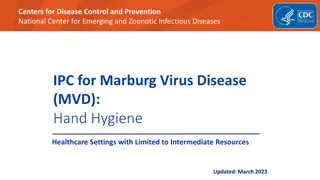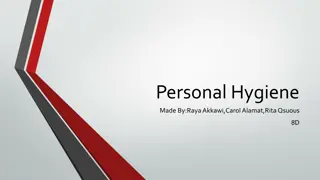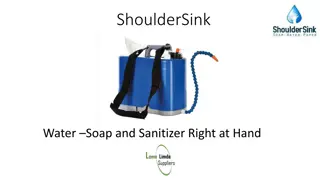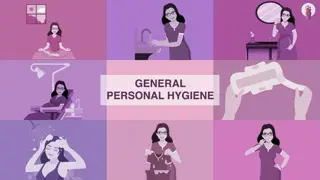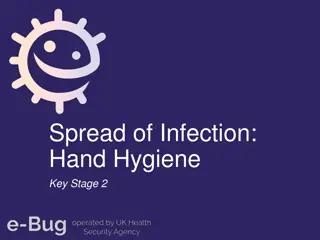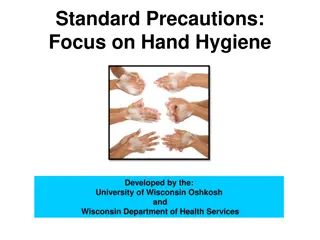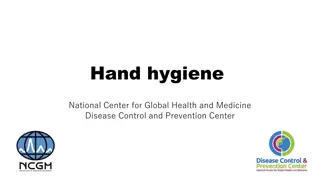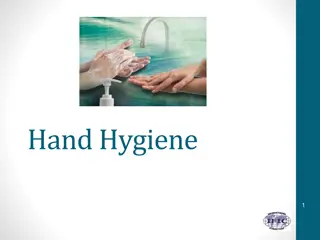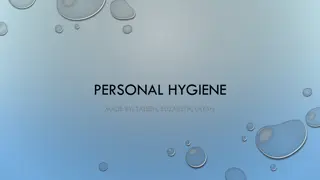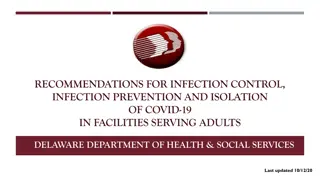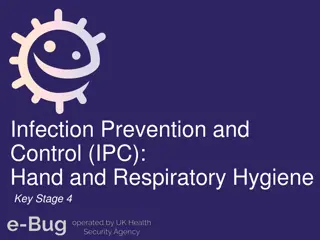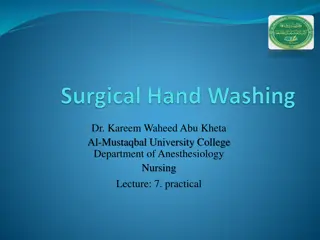Importance of Hand Hygiene Education for Infection Control
Proper hand hygiene is essential for preventing the spread of germs and infections in healthcare settings. This article emphasizes the significance of hand hygiene through education programs, the Clean In, Clean Out method, glove usage, and nail hygiene practices to promote safe resident care and reduce cross-contamination risks.
Download Presentation

Please find below an Image/Link to download the presentation.
The content on the website is provided AS IS for your information and personal use only. It may not be sold, licensed, or shared on other websites without obtaining consent from the author. Download presentation by click this link. If you encounter any issues during the download, it is possible that the publisher has removed the file from their server.
E N D
Presentation Transcript
Hand Hygiene Education Program Clean In Clean Out Method Improving Hand Hygiene at Insert Facility Name 2
Why is hand hygiene important? Hands are the number one way germs are transmitted. The lack of hand hygiene contributes to the spread of resistant microorganisms. It supports safe resident care. 3
Make Cleaning Your Hands A Habit Clean In Clean Out Clean when entering a resident room or care space Clean upon exiting a resident room or care space Why should we Clean In, Clean out? 1. Most of the time when a provider enters a patient room, they make contact with the environment or the patient1: 92.6 % of the time the environment will be touched. 57.4% of the time the patient will be touched. 2. Consistent with leading hand hygiene practice2. 1 Infect Control Hosp Epidemiol 2007; 28:341-345; 2http://www.centerfortransforminghealthcare.org/projects/detail.aspx?Project=3 4
The Facts: Gloves and Hand Hygiene Gloves reduce hand contamination by as much as 70-80% Gloves prevent cross-infection and protect from infection Gloves need to be changed between residents and Hands should be cleansed IMMEDIATELY after glove removal!
More Facts: Gloves and Hand Hygiene Wear gloves when contact with blood or other potentially infectious materials is anticipated.1 Perform hand hygiene before the use of gloves. Two studies illustrated that exam gloves from boxes in use were contaminated 55%2 and 75%3 of the time. Unopened boxes were not contaminated. This finding suggests that staff contaminated the gloves in the open boxes when removing a pair. Perform hand hygiene after the use of gloves. Two studies demonstrated that gloves were highly protective, but hand contamination still occurred 13%4 and 5%5 of the time. Do not wear gloves in the hallway. Do not wear the same pair of gloves for the care of more than one resident. 1Guideline for Hand Hygiene in Health-care Settings. MMWR 2002; vol. 51, no. RR-16. 2 Infect Control Hosp Epidemiol 2008 Jan;29(1):63-5. 3Am J Med 1993 Jun;94(6):602-7. 4JAMA 1993 Jul 21;270(3):350-3 . 5Infect Control Hosp Epidemiol 2008 Feb ;29(2):149-154 . 6
Artificial and Polished Natural Nails Put Residents at Risk Artificial Nails Outbreak of Pseudomonas aeruginosa in a Neonatal ICU resulted in 16 Deaths and was associated with a RN wearing artificial nails. Natural Nails Polished nails are more likely to harbor bacteria than natural nails. Polish should be free of chips. 1 40 35 3 people suffered Candida bone infections after spine surgery. The infection was associated with an OR Tech wearing artificial nails. % Recovery of gram negative Natural (n=31) 30 Artificial (n=27) 2 bacteria3 Polished (n=31) 20 ARTIFICIAL 10 10 5 0 p<0.05 POLISHED NATURAL Artificial nails are prohibited in direct patient care providers, food handlers and those handling sterile supplies. Keep natural nails <1/4 inch if caring for patients. 1 Outbreak of Pseudomonas aeruginosa in a neonatal intensive care unit - Moolenaar RL et al, Infect Control Hosp Epidemiol 21(2):80, 2000; 2 Candida Osteomyelitis and Diskitis after Spinal Surgery Parry et al, Clinical Infectious Diseases 32:352-7, 2001; 3 Larson, Nursing Research 1998; 47:54 7
Hand Rub vs. Soap and Water HANDWASHING (soap and water) Pros: 1. Effective for all situations. HAND RUB (foam and gel) Pros: 1. Takes less time 2. Contains moisturizers 3. Readily accessible Cons: 1. Can t be used for situations with gross contamination Cons: 1. 2. 3. Takes more time Can be more drying than foam/gel Sink and soap not always nearby Technique: Apply to palm of one hand (the amount used depends on specific hand rub product and the size of your hands). Rub hands together, covering all surfaces, focusing in particular on the fingertips and fingernails, until dry. Technique: Wet hands with water. Apply soap. Rub hands together for at least (insert facility time) seconds, covering all surfaces, focusing on fingertips and fingernails. Rinse under running water and dry with disposable towel. Use the towel to turn off the faucet. 8
Speak Up for Resident Safety Resident safety is a team effort. Be empowered to speak up and remind a colleague if they forget to perform hand hygiene. Lead by example. 9 9
In Conclusion Clean In, Clean Out. Clean hands before and after the use of gloves. Speak up for clean hands. 10




